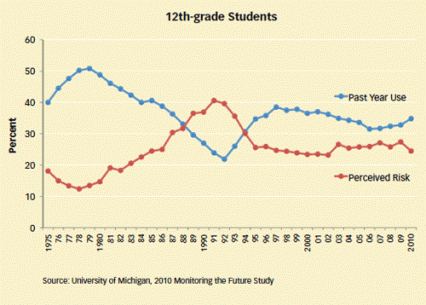A growing percentage of students in the 8th, 10th, and 12th grades are using marijuana on a regular basis, according to the 2010 Monitoring the Future (MTF) survey. Most notably, daily marijuana use increased by more than 10 percent in all three grades since the 2009 survey.
Driven by the rise in marijuana use, illicit drug usage among teenagers has increased overall in the past 3 years. Rates of past-year illicit drug use in 2010 were 16 percent in the 8th grade, 30 percent in the 10th grade, and 38 percent in the 12th grade. The findings, presented at a December 2010 press conference, corroborate the results of the National Survey on Drug Use and Health, released last September ("Drug Abuse at Highest Level in Nearly a Decade").
The MTF survey also found that ecstasy use, though much lower than marijuana use, increased in 2010, and a long-term decline in cigarette smoking that had been documented in past MTF surveys has leveled off. Alcohol use, however, has fallen to the lowest levels in the history of the survey.
The recent rise in marijuana use follows a 10-year period of decline. In 2010, 1.2 percent of 8th-graders, 3.3 percent of 10th-graders, and 6.1 percent of 12th-graders reported daily marijuana use—defined as 20 or more occasions in the past 30 days. Rates on all measures (daily, past-month, past-year, and lifetime use) increased over the previous year when data for all three grades were combined. In addition, past-month marijuana use among 12th-graders (21.4 percent) surpassed past-month cigarette smoking (19.2 percent).
Marijuana use not only places teens at risk of addiction but also impairs their memory, judgment, and ability to learn, says NIDA Director Dr. Nora D. Volkow. "Do we want to jeopardize their future achievement due to exposure to marijuana?" she asks. Eighth-graders, the youngest group surveyed, are especially vulnerable to the drug's harmful effects, she adds, yet in 2010 they reported increases in daily, past-month, and past-year use.
Since the mid-1970s, whenever 12th-graders report a heightened perception of the risks associated with using marijuana, their use of the drug has declined; conversely, when their perception of risk diminishes, their use increases. Dr. Volkow speculates that the recent increase in teen use may be caused by the "attention that the potential use of marijuana as a medication has generated," contributing to an under-appreciation of the harm associated with the drug, and she calls for new research in this area.
Ecstasy Makes a Comeback
Ecstasy use rose in 2010 for the first time in nearly a decade. Use of the drug took off in the late 1990s, peaked in 2001, plummeted immediately afterward, and then leveled off. Dr. Lloyd Johnston of the University of Michigan, the survey's principal investigator, says the revival of interest in ecstasy is due to "generational forgetting"—the current generation of teens is unaware of the drug's harmful effects and so is willing to try it. Use rates rose from 1.3 percent in 2009 to 2.4 percent in 2010 among 8th-graders and from 3.7 percent to 4.7 percent among 10th-graders; there was, however, no increase in use among 12th-graders during this time span. In 2009, Dr. Johnston had predicted that an increase was likely because MTF surveys over the past several years showed a softening of perceived risk ("Adolescent Cigarette Smoking Holds at Lowest Recorded Levels").
 Increases in Marijuana Use Correspond to Declines in Risk Perception: Over the past 35 years, the percentage of 12th-grade students reporting past-year marijuana use has shown ups and downs. Such use has risen when risk perception falls and has fallen when risk perception rises
Increases in Marijuana Use Correspond to Declines in Risk Perception: Over the past 35 years, the percentage of 12th-grade students reporting past-year marijuana use has shown ups and downs. Such use has risen when risk perception falls and has fallen when risk perception risesThe 2010 findings for other substances include:
- Alcohol. A long-term decline continued; past-month use for the three grades combined fell to 26.8 percent, from 28.4 percent in 2009.
- Prescription and over-the-counter medications. The only significant change in past-year nonmedical use occurred for Vicodin, a narcotic pain reliever, which fell to 8 percent among 12th-graders, from 9.7 percent in 2009. There was no change in past-year nonmedical use by 12th-graders of the pain reliever OxyContin (5.1 percent); of Adderall (6.5 percent) and Ritalin (2.7 percent), which are prescribed mostly to treat attention deficit hyperactivity disorder; or of over-the-counter cough and cold medicines (6.6 percent).
The 2010 survey covered 46,482 students in 396 public and private schools across the contiguous 48 States. Further information on the survey is available at Monitoring the Future and at www.monitoringthefuture.org.
